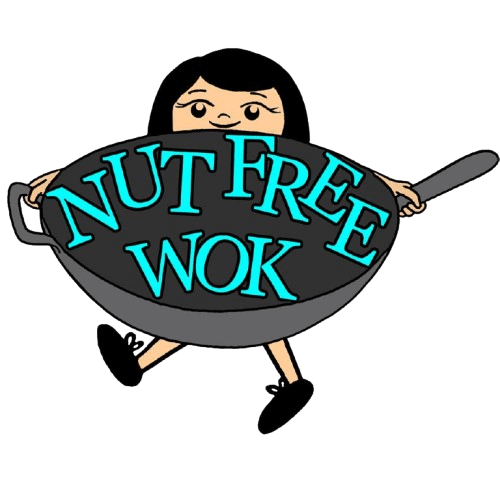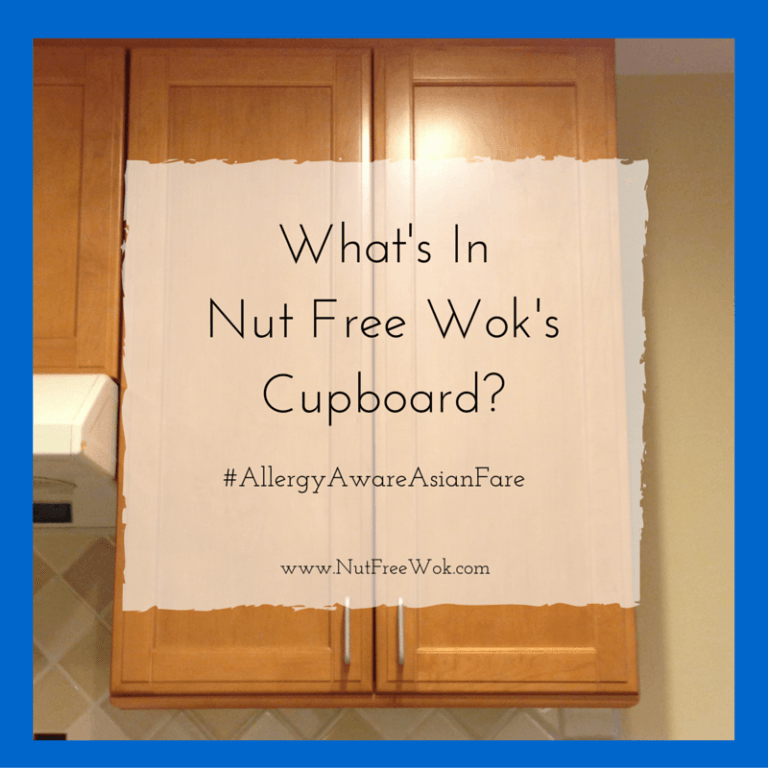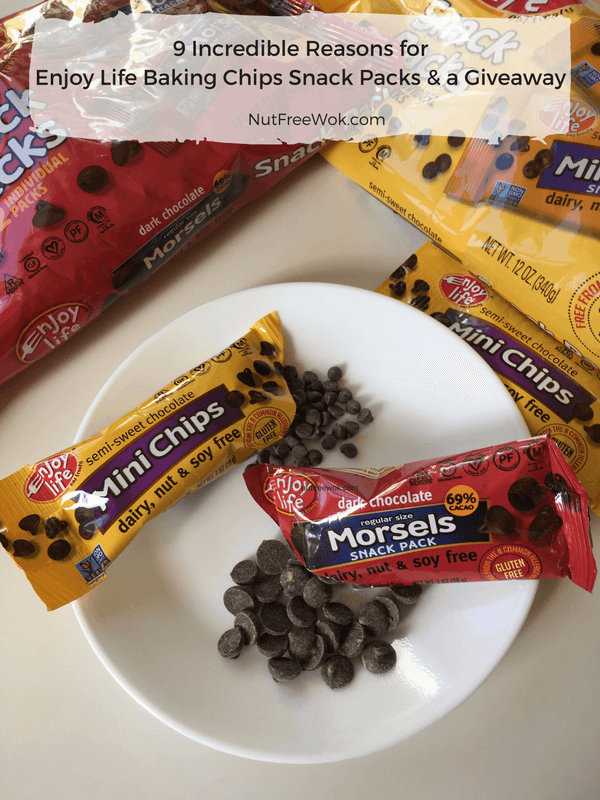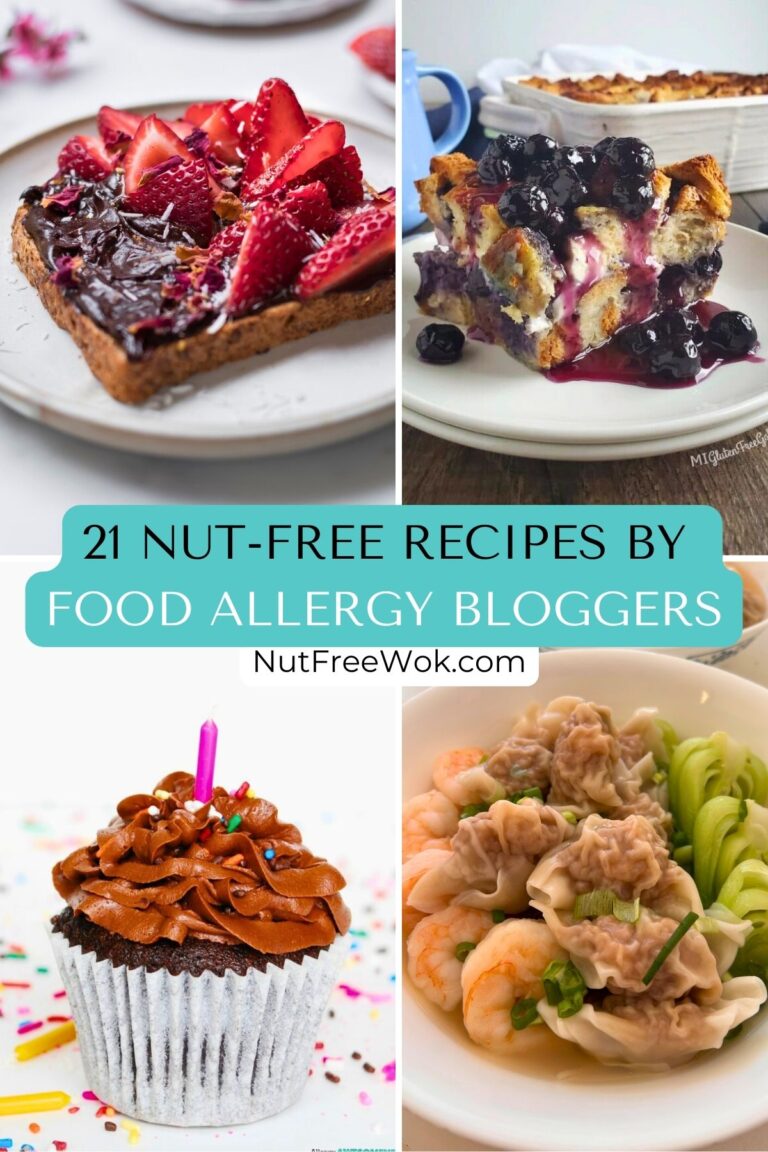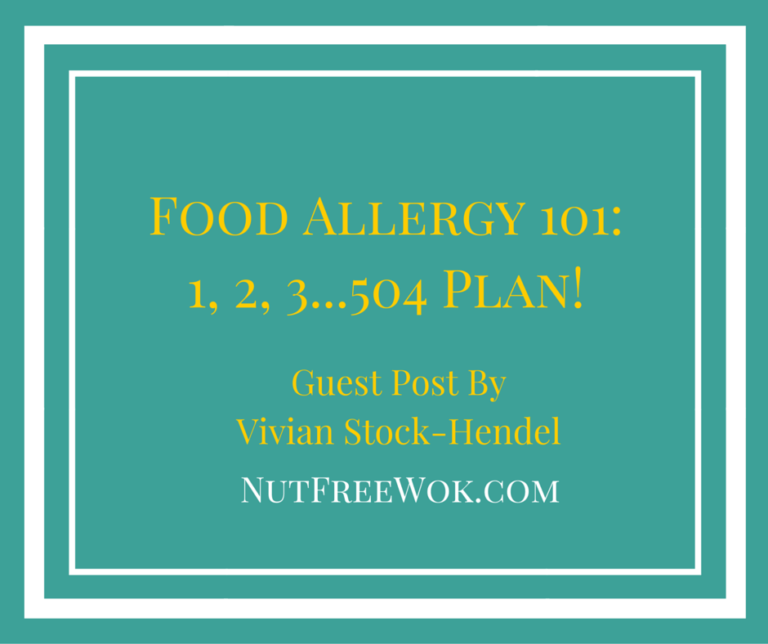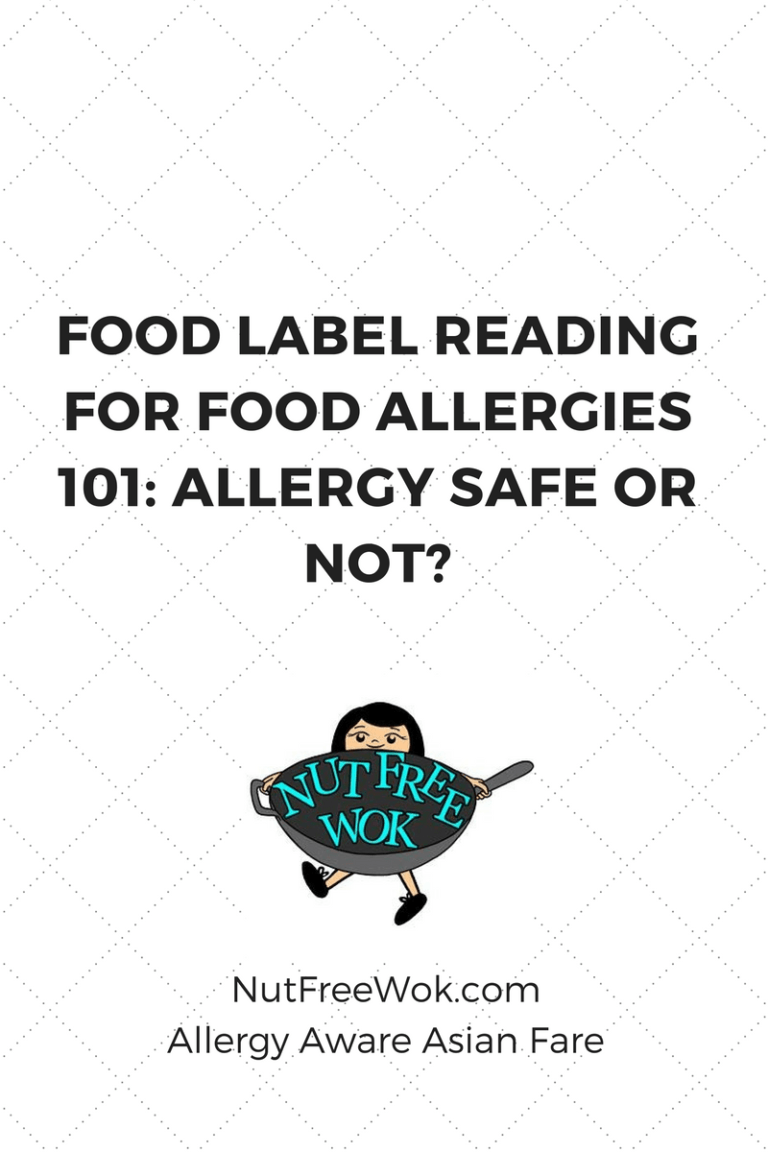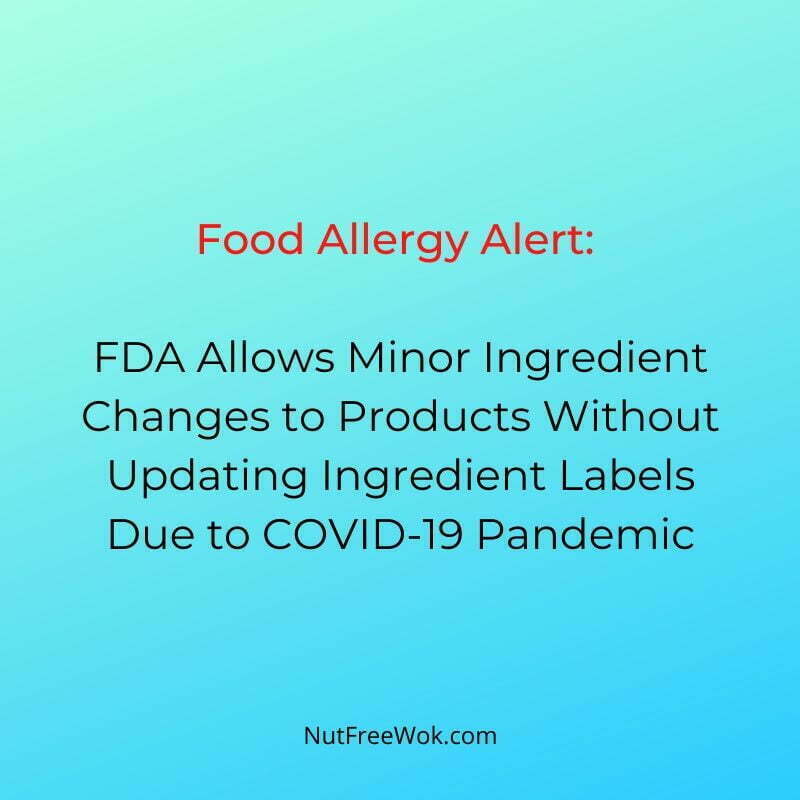
FDA has recently released “Temporary Policy Regarding Certain Food Labeling Requirements During the COVID-19 Public Health Emergency: Minor Formulation Changes and Vending Machines: Guidance for Industry” due to food supply issues that impact food manufacturer’s ability to manufacture their products.
Update (August 2023): I’ve been wondering whether these exemptions are still allowed and found an update from the FDA, “FDA Issues Federal Register Notice to Announce Status of COVID-19 Guidance Documents When Public Health Emergency Expires” Basically, most of them have been archived and the remaining guidances will be archived in November 2023. I still recommend caution because some affected products might be canned or frozen and available to eat in 2024.
People managing life with food allergies already have challenges with finding food that is allergen safe for them as it is. Ingredient labels have been required to list the ingredients but not allergen advisories regarding potential cross contact, which may introduce allergens inadvertently.
The COVID-19 pandemic makes grocery shopping even more challenging when stores might not have our trusted brands of food products in stock. To allow food manufacturers to reduce, omit, or substitute ingredients without updated labeling puts food allergic consumers at risk of anaphylaxis, a life threatening reaction.
I believe that these relaxed ingredient label guidelines shared by the FDA should be a very concerning topic for individuals with food allergies and we must all speak up. It’s definitely a situation in which what we don’t know might hurt us. In fact, the FDA does give us an opportunity to submit comments by mail and online. Be sure to include the docket number and complete title of the guidance to reference this topic when submitting a comment.
Comments may be submitted at any time for FDA consideration. Submit written comments to the Dockets Management Staff (HFA-305), Food and Drug Administration, 5630 Fishers Lane, Rm. 1061, Rockville, MD 20852. Submit electronic comments to https://www.regulations.gov. All comments should be identified with the docket number FDA-2020-D-1139 and complete title of the guidance in the request.
Note that the FDA shared this “temporary” policy update at the request of manufacturers in section II. “…the food industry has informed us that there are supply disruptions or shortages for some ingredients and, as a result, manufacturers will need to make formulation changes, such as omissions or substitutions of minor ingredients, in the manufacturing of some foods. “
And note that the changes might not be temporary (top of page 5). “Therefore, upon termination of the public health emergency, FDA intends to consider and publicly communicate regarding whether an extension, in whole or in part, is warranted, based on comments received to this guidance and our experience with its implementation.”
What Changes Will Be Allowed:
Here’s a quote of what changes will be allowed (pages 6-7).
For purposes of this guidance, minor formulation changes should be consistent with the general factors listed below, as appropriate:
• SAFETY: the ingredient being substituted for the labeled ingredient does not cause any adverse health effect (including food allergens, gluten, sulfites, or other ingredients known to cause sensitivities (see section C.2.a) in some people, for example, glutamates);
• QUANTITY: generally present at 2 percent or less by weight6 of the finished food;
• PROMINENCE: the ingredient being omitted or substituted for the labeled ingredient is not a major (prominent) ingredient (for example, replacing rice flour for wheat flour in a muffin) or an ingredient that is the subject of a label statement (such as, butter in a cookie with a “Made with real butter” claim);
• CHARACTERIZING OR INGREDIENT IN NAME: the ingredient being omitted or substituted for the labeled ingredient is not a characterizing ingredient (such as omitting raisins in a raisin bread) where the presence of the ingredient has a material bearing on consumer purchasing;
• CLAIMS: an omission or substitution of the ingredient does not affect any voluntary nutrient content or health claims on the label; and
• NUTRITION/FUNCTION: an omission or substitution of the labeled ingredient does not have a significant impact on the finished product (including nutritional differences or functionality).
Some Ingredient Label Changes that Are Allowed:
The FDA also points out that it’s already allowed for manufacturers to use generic (vague) terms for flavoring and spices, certain colors, and the use of “and/or”. What do they mean by “as appropriate.”?
I wish that the statement “minor formulation changes should be consistent with the general factors listed below,” were “minor formulation changes must be consistent with the general factors listed below.” Suggesting that changes should not cause any safety concerns is vague and even more open ended than before the COVID-19 pandemic became a concern.
I highly recommend that you read pages 8-9 for more specific examples of what will be allowed.
Reduction or ommission of ingredients – In my opinion, this change might not be harmful but as a consumer, but it might not taste the same as before or you might not get what you pay for.
Substitutions of Minor Ingredients at Less Than 2 Percent – This change is the most dangerous change because the policy will allow substitution changes as long as there are “no safety or allergen concerns introduced.” The FDA also mentions avoiding top allergens for other countries including Canada, European countries, and Japan but there are still many other non-top allergenic ingredients that can cause anaphylaxis even in small amounts.
Substitutions of Different Varieties of the Same General Ingredient That May be Present at Greater Than 2 Percent – the FDA specifically mentions allowing substitutions of varieties of the same ingredient and allowing substitutions of fats and oils. The FDA considers highly refined oils as non-allergenic but my personal policy is that if I avoid products that “may contain” a certain allergen, then I will avoid a highly refined oil of that allergen.
The new policy also relaxes guidelines regarding vending machines. I usually don’t buy vending machine products for my children due to food allergies because it’s just easier to carry a safe snack. However there have been instances when we were stuck in unexpected circumstances and ate our snacks and our back up snacks. If you rely on vending machines, be aware that changes in vending machine product labeling may impact you and be sure to read page 11.
What Does This Mean for People with Food Allergies
These relaxed guidelines will impact those who have non-top 8 allergens the most because the FDA will allow substitutions of “similar” ingredients. If the changes are not on the ingredient label, how will anyone who relies solely on the ingredient label ever know to be concerned? How will they know they will need to call a manufacturer or visit their website to check? What if they are unable to call or go online?
We will be at greater risk of inadvertent introduction of top 8 allergens due to cross contact. Because of the food supply issues and these relaxed guidelines, it’s entirely possible that food manufacturers might change vendors of the ingredients of they use to make foods which could affect the risk of inadvertent introduction of allergens via cross contact. For example a bakery might switch from using flour made in a nut free facility to a flour made in a facility with shared equipment with nuts or other allergens. We need to close the loopholes regarding allergen advisories, not loosen guidelines.
Flexibility to substitute ingredients will also impact people who have any spice allergies, especially an allergy to sesame, which is in consideration for being designated as the 9th most common allergen in the US. The FDA currently allows food manufacturers not to specify what spices are used and allow the ingredients to be listed with a vague term such as “spices.” As a former sesame allergy mom, I know how frustrating it is to call a manufacturer to ask “does your product contain sesame” and to be told that they won’t disclose their proprietary ingredients.
The danger of less regulated ingredient labels on shelf stable or freezer products will impact us for months if not years. Products with substitution or other changes allowed by this new policy might remain on store shelves, consumer cupboards and freezers, food banks, and restaurants for months or years after the pandemic is over.
Lastly, as if these new relaxed temporary guidelines aren’t risky enough, there is a possibility that even when the pandemic is over (within the next 1-5 years, depending on whether you are optimistic or pessimistic), that these temporary guidelines might be extended or become permanent. If the relaxed guidelines are acceptable during a pandemic, why wouldn’t they be acceptable when various supply and manufacturing issues return to “normal.” We have been forewarned. Read this excerpt found on pages 4-5.
This policy is intended to remain in effect only for the duration of the public health emergency related to COVID-19 declared by the Department of Health and Human Services (HHS), This guidance represents the current thinking of the Food and Drug Administration (FDA, Agency, or we) on this topic. It does not establish any rights for any person and is not binding on FDA or the public. You can use an alternative approach if it satisfies the requirements of the applicable statutes and regulations. To discuss an alternative approach, contact the FDA staff or Office responsible for this guidance as listed on the title page. Contains Nonbinding Recommendations 5 including any renewals made by the HHS Secretary in accordance with section 319(a)(2) of the Public Health Services (PHS) Act (42 U.S.C. 247d(a)(2)). 1 However, we recognize that the food and agricultural sector may need additional time to bring its supply chains back into regular order. Therefore, upon termination of the public health emergency, FDA intends to consider and publicly communicate regarding whether an extension, in whole or in part, is warranted, (emphasis mine for editorial purposes) based on comments received to this guidance and our experience with its implementation.
It behooves all of us to contribute our comments to the FDA. Go to their site at www.regulations.gov and be sure to mention the full title of the document and the docket number (mentioned at the beginning of this article).
A Real Life Example of Changes That We Didn’t Know
Have you purchased eggs recently and have you noticed anything unusual about your eggs? I noticed that my eggs are of varying sizes.
As I was preparing to write this article, I discovered that the FDA has relaxed their standards about how eggs are packaged and label in order to meet demand during this pandemic. According to an article by Today.com, “The biggest change consumers may find is that eggs of different grades and sizes may be boxed together.”
Eggs not properly labeled for size and grade won’t cause any life threatening issues and at worse will mess up my baking. But it’s a good example of how subtle changes can happen without our knowledge.
Please add your concerns to the FDA’s comments and share this article with others so that we can all be aware and stay safe from life threatening allergic reactions. Be sure to have your epinephrine auto injector accessible at all times.
Additional Resources:
I love Allergic Living’s write up about this issue with analysis from some of my favorite people, Mary Vargas, Homa Woodrum, and Colleen Kavanaugh. Many thanks to SnackSafely.Com, FARE, AAFA/KFA, AAN, and FAACT for their advocacy efforts as well.
Save Lives! Please Write to the FDA and Please Share <3

Thanks for reading, please help Nut Free Wok!
If you like this post or recipe, please be sure to give a 5 star rating, leave a comment, and share this post! Your support means a lot to me.
Subscribe to Nut Free Wok’s email subscription (be sure to respond to the confirmation email). You will be notified by email next time I publish another post or recipe and I won’t send you spam or share your email address with anyone.
Disclosure/Disclaimer:
I may mention the names of stores and/or brand names of products that I use because readers ask and I share products and sources which I use and think may be helpful to readers, all opinions are my own. Please note that manufacturing practices and ingredients can change at anytime without notice and readers are always responsible for assuring allergen safety before buying or consuming foods. NutFreeWok.com is a participant in the Amazon Services LLC Associates Program, an affiliate advertising program designed to provide a means for sites to earn advertising fees by advertising and linking to Amazon.com. Thank you for reading!
